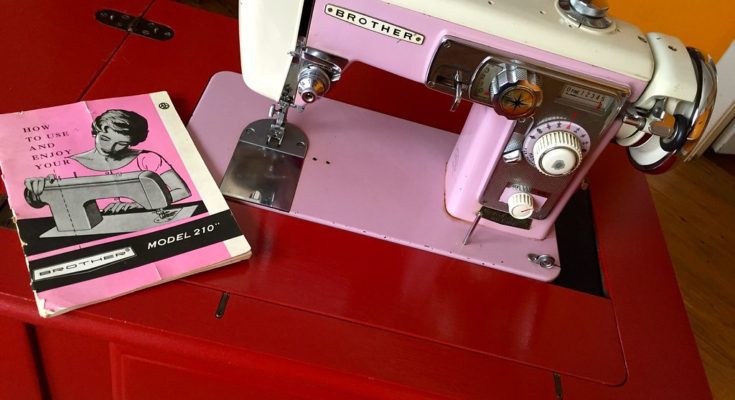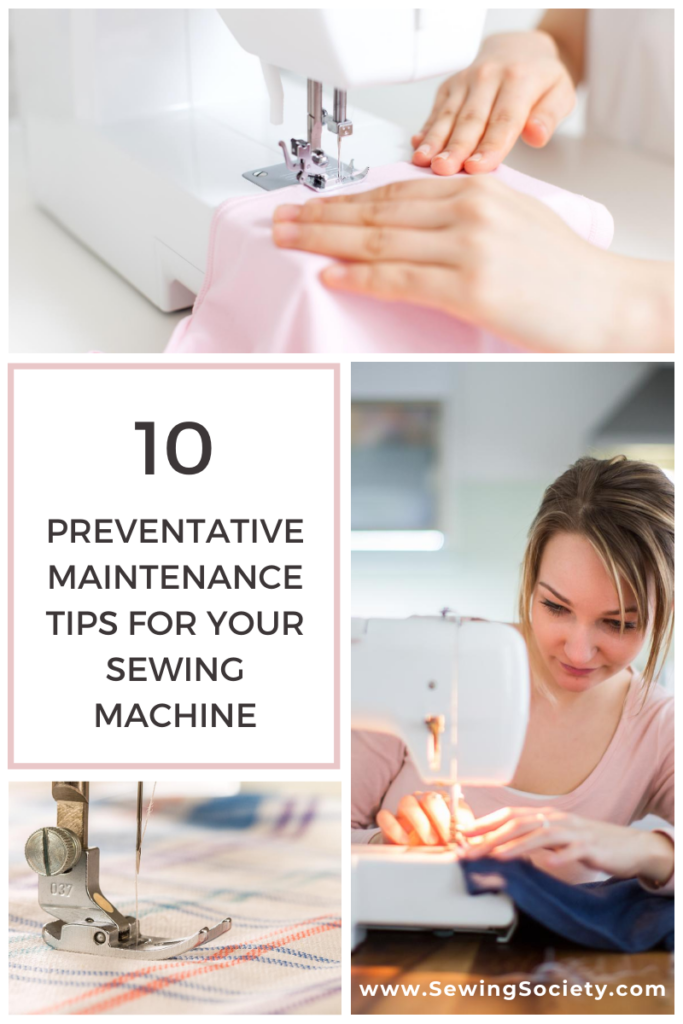Disclosure: This post may contain affiliate links. I earn a small commission when you click a link and make a purchase. Thanks for supporting SewingSociety.com!
Most sewing machine problems are the result of improper maintenance. If you want your sewing machine to have a long life, you need to take care of it! Here are ten preventative maintenance measures to ensure your sewing machine lasts for many years to come.
Contents
Store Your Sewing Machine in a Cool, Dry Place
When you’re not using your sewing machine, store it someplace safe and secure. You don’t want to expose the machine to extreme temperatures or humidity. Hot and cold temperatures mixed with oil and lint create crud on the moving parts of your sewing machine that prevent it from working properly. Eventually, this crud will corrode the metal parts in your machine.
The worst place to store your sewing machine is in the trunk of a car. The temperatures are not controlled, and your sewing machine can be damaged easily. Store it in a cabinet, in a sturdy case, or on a table with a dust cover.
Use a Surge Protector
Never plug your sewing machine directly into an outlet. A power surge can permanently damage the electrolytic capacitors in your machine, and you can’t predict when the surges will happen. Buy a surge protector to protect your sewing machine. If you can’t use a surge protector, at least unplug your sewing machine when it’s not in use.
Clean and Oil Your Sewing Machine Frequently
Lint and dust build up in your bobbin case and thread take-up lever as you sew. It should be cleaned out after every project. Use a soft brush and follow the instructions in your user manual to clean your sewing machine.
You should also apply oil to the moving parts of your sewing machine after every few projects. Don’t apply too much — one or two drops will do. This will keep the gears turning smoothly. However, not all sewing machines require oiling. Computerized sewing machines are often self-lubricating. Check your user manual to see if your sewing machine requires oiling.
Change Your Needle Every 6 to 8 Hours of Sewing
Your needle needs to be sharp to pierce your fabric and form stitches the way it is supposed to. As you sew, your needle gets dull from all the friction and heat. This happens faster on embroidery machines or if you’ve been using a lot of decorative stitches. Change your needle every 6 to 8 hours to prevent skipped stitches and puckered seams. Replacement sewing machine needles are inexpensive and easy to change.
Don’t Sew Over Pins
If your needle strikes a pin as you sew, it can bend your needle, mess up the timing of your machine, knock your needle bar out of alignment, and cause other problems. Remove the pins from your fabric just before they go under your presser foot. If you have a hard time seeing the pins as you sew, use pins with bright-colored heads.
Never Pull on Your Fabric as You Sew
The feed dogs on your sewing machine are designed to pull your fabric through your machine smoothly and evenly. If you pull on your fabric as you sew, you can damage your needle and get puckered seams and skipped stitches. Let your sewing machine do the work for you. If you’re sewing on thick fabric or through multiple layers, consider using a walking foot attachment to help feed your fabric through your sewing machine more easily.
Use High-Quality Thread
Old and poor-quality thread snaps easily and causes all sorts of sewing machine problems. It can snag and break your needle, mess with your tension, and cause a lot of extra lint. Always spend a few extra cents to get high-quality thread. It will save you a lot of stress because your sewing machine will run properly and your seams will look better.
Avoid buying thread in bulk packages. It is typically of poor quality. Don’t be allured by all the color options that you’ll have on hand. Besides, it’s better to buy your thread at the time you purchase your fabric so you can get a better color match. You can tell if the thread is poor-quality by allowing 10 to 12 inches to hang down. If the thread looks fuzzy or does a lot of curling, don’t use it.
Pull Your Bobbin Thread Up Before You Start to Sew
Your upper thread and bobbin thread work together to form stitches on your fabric. Make sure to always pull your bobbin thread up through the needle plate so your stitches can form properly. Turn the handwheel towards you to make your needle go down into the bobbin case and grab your bobbin thread. Then, pull the bobbin thread up before you feed any fabric through your sewing machine.
Adjust Your Sewing Machine Tension at the Beginning of Every Project
Fabric comes in different thicknesses and each needs a slightly different tension setting to form smooth, even stitches. Before you start sewing on new fabric, adjust the tension on your sewing machine so that you see no loops on either side of your fabric. You may also need to adjust your presser foot pressure.
Try to avoid adjusting your bobbin thread tension. It is preset by the manufacturer. However, if you do need to adjust it, the tension screw is located on the bobbin case. Make very small adjustments until your stitches look right.
Get a Tune-Up Every 1 to 2 Years
Even with proper care, you should still take your sewing machine into a repair shop for a tune-up every one to two years, depending on how much you sew. They will thoroughly clean your machine, look for damaged parts, adjust your timing, and tighten any loose screws inside your machine.
Preventative maintenance will help keep your sewing machine out of the repair shop. Unfortunately, sometimes problems still happen… I created a sewing machine troubleshooting guide to help you find solutions to the most common sewing machine problems. You can get your copy here: Sewing Machine Problems and How to Solve Them.
Did you find this article helpful? Share it on Pinterest!






I had no idea that the the needle gets dull from all the friction and heat during the sewing process. Maybe thats the reason why I had an issue with my sewing machine. Since I am looking for a repair company, I find this piece helpful. I’ll then follow your tips for maintenance once it got fixed.
This is such a useful piece. I’m constantly guilty of neglecting to care for my machine because when I have the time, I’d honestly rather sew than housekeep since I figure I can put it off. But this is a good list of things I should be doing, thank you!